Introduction: the Industrial Revolution
The Industrial Revolution took place between 1750 – 1900. It was a period of great change in Britain and it turned Scotland into a country where most people lived in cities and towns and worked in new industries.
For most Scots, life became very different from the rural world of farming that had existed for centuries.
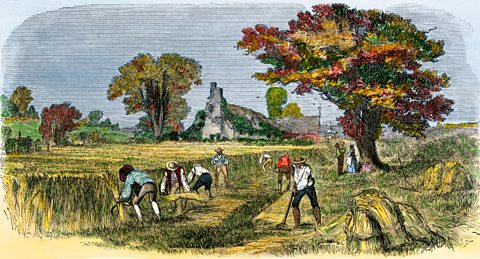 Image source, ALAMY
Image source, ALAMYRural life before the Industrial Revolution
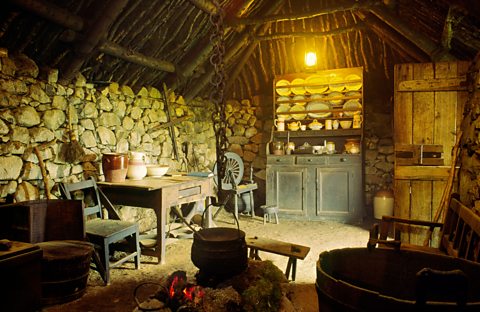 Image source, ALAMY
Image source, ALAMYToday most people in Scotland live in urban areas - large towns or cities.
But for centuries before the Industrial Revolution, most people in Scotland lived in rural areas - most lived with their families in small settlements, such as fermtouns and clachans that were made up of just a few cottages.
Families lived in the same area for generations and in many rural areas, there was little reason to leave. As the Statistical Account of Scotland (1790-99) put it:
Few leave the country, if they can procure a house, which is easily built, with a spot of ground for crop, and a cow's grass.
 Image source, ALAMY
Image source, ALAMYTravel
Travel was difficult because there were few roads and little in the way of public transport.
As a result, people lived and worked on land near where they were born – often living in the same settlement all their lives because they couldn’t afford to leave and had nowhere else to go.
Religion
Religion was a very important influence in rural, pre-industrial society, and provided stability and structure.
Scotland was divided into districts called parishes. At the centre of each parish was the church.
The church provided essential services such as weddings, baptisms, and funerals, and also served as a local court dealing with moral or social offenses in the community.
Each parish was responsible for the provision of basic forms of welfare to poorer members of the community.All of this made the church – and religion – very important in people’s lives.
Health
While the Industrial Revolution led to progress in science and engineering, for the workers the it led to a decline in health. This was due to worsened living conditions in towns and cities, and poor sanitation.
Before the Industrial Revolution, most people lived in rural areas where they had cleaner air and better conditions.
Life before industrialisation, was not without challenges. Medical knowledge and access to medicine was limited. Diseases that we easily treat today could be deadly in this period.
The common diet was limited to the food that people could grow or catch locally. This had an effect on health as diets could be very restricted and subject to shortages when harvests failed.
Working life before the Industrial Revolution
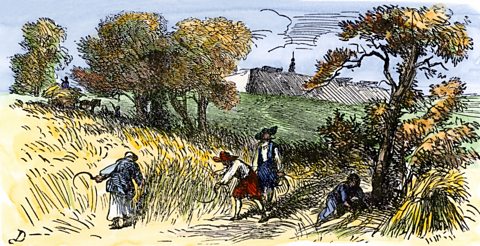 Image source, ALAMY
Image source, ALAMYMost people lived by subsistence farmingGrowing crops or rearing animals to feed yourself and your family. Subsistence farmers do not grow food to sell, so only sell food if they grow more than they need., dividing up land to grow crops and sharing land for grazing animals.
People did not own the land they farmed or lived on. They were tenant farmers, paying rent to a small number of landowners, or carrying out work for the landowner when needed.
In Lowland Scotland, land was owned by members of the nobilityThe people at the top of the social hierarchy with lands, large homes and connections to the monarch and their court., like dukes, earls or lairds.
In the Highlands and western Scotland, land was owned by clan chiefs from the most prominent local families.
As well as growing and harvesting their own crops, the tenant farmers were expected to work the fields and harvest the crops of the landowners.
The methods of farming the land had not changed from generation to generation.
People and livestock like horses or oxen were the only form of power, which meant work like ploughing was time consuming and labour-intensive.
Farm work was dependant on the growing seasons.
This meant that work was seasonal and – during winter months when there were no crops to harvest – people could struggle to find employment.
Times were often hard when the weather destroyed the harvest. The tenant farmers would still have to pay their rent and would go hungry if they couldn’t afford to buy food.
 Image source, ALAMY
Image source, ALAMYCottage industry
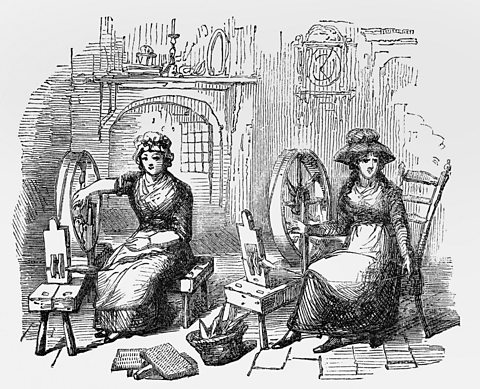 Image source, ALAMY
Image source, ALAMYIn some cases, people, mostly women, would make some extra income by making cloth in their own homes.
They would use simple spinning wheels to spin yarns and threads, which they would then weave on handlooms. Flax was grown to make linen, and sheep were kept to provide wool.
This system is called the domestic system or cottage system because it involved people making cloth in their own homes.
 Image source, ALAMY
Image source, ALAMYChanges in rural life during the Industrial Revolution
Before the Industrial Revolution, life had changed very little for hundreds of years. The coming of industry and factories would change life and work in Scotland, with people moving from rural areas and the growth of cities.
Changes had already begun in the countryside as a result of what is sometimes called the agricultural revolution.
Agricultural Revolution
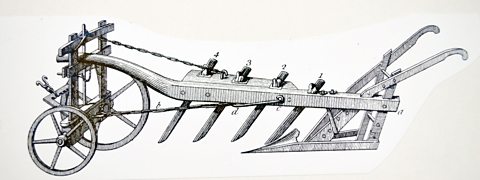 Image source, ALAMY
Image source, ALAMYBefore the Industrial Revolution, Scotland’s rural areas were experiencing significant changes in what came to be called the Agricultural Revolution.
In the early 1700s, many Scottish landowners began a series of reforms designed to improve the quality of the farmland and to produced better harvests of crops. They were interested in making land more productive, and making more profit.
Waterlogged land was drained, new crops were introduced to Scotland such as turnips and cabbages, and more land was given over to grazing sheep and cattle. New equipment, such as lighter, better ploughs that could be pulled by horses rather than oxen were also introduced.
While many of these reforms did much to transform the productivity of Scottish farming, these changes did have negative effects for some and brought an end to the traditional rural way of life.
 Image source, ALAMY
Image source, ALAMYThe Galloway Levellers
Find out how the changing nature of rural work led to a violent protest by mobs called the Galloway Levellers.
It’s 1724, and armed gangs prowl the Galloway countryside, bubbling with rage because landowners are enclosing common land – walling off shared land to keep cattle and make bigger profits. Meaning that families living off the land are struggling to feed their own livestock, making a way of life that went back generations nigh on impossible.
Under the cover of darkness, a thousand-strong armed mob knock down walls of livestock enclosures, earning a nickname – the “Galloway Levellers”.
But as landowners call in the army to keep order, things turn violent. The sides clash ferociously and one Leveller’s ear was cut off by a sword. Ultimately, with the law on their side, the landowners won – and tenants were forced to leave the countryside to find new ways of life.
So, before these riots, life in rural Galloway hadn’t changed much in hundreds of years! The land was owned by wealthy landlords, often Dukes, Earls, and Lairds, but it was worked by tenant farmers, families that had lived like this for generations.
They rented land where they grew crops like barley, oats, and potatoes, and they shared patches of common land where they grazed their own sheep and cows. It was a hard life – families scraped by but had no money.
Most tenant paid the rent through the work they did on the landlord’s farms. But, times were changing. New farming techniques, new crops like cabbages and turnips, and new, more efficient ploughs, meant that farms could be run for a bigger profit while using fewer workers. Bad news for tenant farmers who needed that work to pay their rents.
Even worse, landlords took back the common land and built chunky stone walls to keep in large herds of profitable cattle. Without common land, tenant families couldn’t feed their own animals. And without animals, they could go hungry and lose an important source of income.
It was these stone walls that the Galloway Levellers smashed in anger. But, as you’ll remember, the protests ultimately failed, signalling the end of a way of life for many in southern Scotland.
Between 1760 and 1830, struggling tenant farmers left the lowlands in droves. Thousands emigrated to Canada, many other left for the rapidly expanding cities such as Glasgow, where they could work in factories and be guaranteed paid employment all year round.
In Lanarkshire alone between 1755 and 1791, the rural population dropped by a third.
In the 1700s in Galloway, in the south of Scotland, local landowners realised that they could make more money by raising large herds of cattle to sell across the border in England.
To raise these large herds, the landowners closed off access to common pasture by building stone walls. Tenant farmers had no legal protection to stop this. Loss of common land meant that tenant farmers couldn’t raise and feed their own animals on this land.
Land used for large herds of cattle required fewer people to work on it than before. As a result, many Galloway families did not have extra work to bring in an income, or through which they could earn their rent.
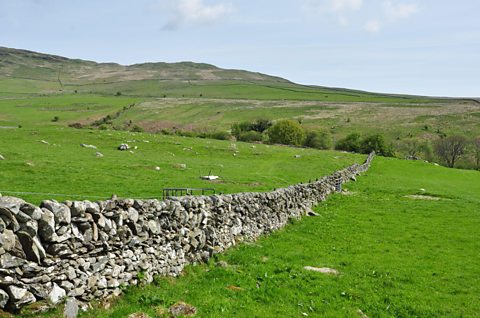 Image source, ALAMY
Image source, ALAMYIn 1723, many tenant farmers in Dumfries and Galloway took action against the enclosure of land.
Large gangs of armed rural workers protested by destroying the stone walls that enclosed their old pasture lands – earning themselves the nickname, the Galloway Levellers.
The protests were serious enough for the army to be called in to keep the peace. During the clashes, some people were injured.
In the end, the landlords won and many of the Levellers were arrested. Over the next hundred years, more and more land was closed off for cattle and sheep. Thousands of rural families were forced to leave their homes to find paid work elsewhere. Some found factory work locally in towns like Hawick, while others became workers in cities such as Glasgow.
This de-population of the southern area became known as the Lowland Clearances.
 Image source, ALAMY
Image source, ALAMYThe Highland Clearances, 1730s – 1850s
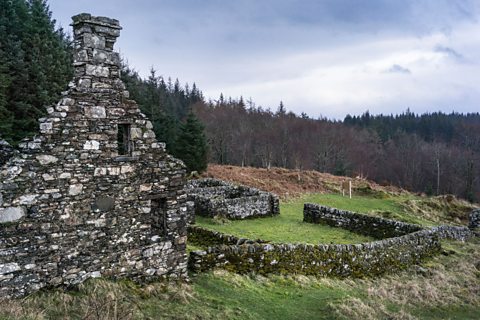 Image source, ALAMY
Image source, ALAMYThe Highland Clearances were a process that saw lots of people forces from their homes in the Highlands and Islands of Scotland to towns and cities elsewhere – sometimes even to other countries such as Canada and Australia.
During this period of around 100 years, the clan chiefs and landlords realised that raising sheep on their lands was more profitable than leaving land to be worked by peasants and tenant farmers.
As a result, whole communities were moved off the land and made homeless. Some people who refused to move had their cottages burned down.
Many were initially resettled in coastal areas where they earned a living harvesting kelp and other seaweed.
Many others settled in Scottish towns and cities such as Glasgow, Inverness, and Edinburgh.
Unable to use their skills as farmers, these new settlers would typically work in the growing number of factories.
 Image source, ALAMY
Image source, ALAMYPotato blight and famine
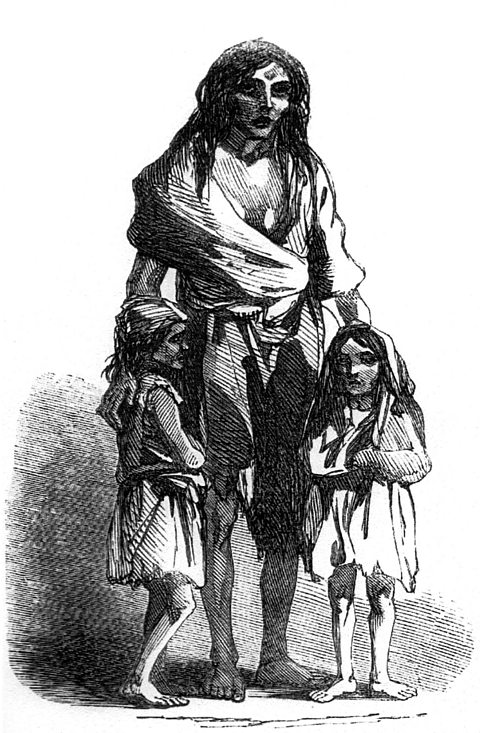 Image source, ALAMY
Image source, ALAMYDuring the 1840s, a series of severe failures of potato harvests led to famine in Ireland and parts of the Scottish Highlands.
In Ireland, more than a million people died of hunger and another million left Ireland.
Many emigrated abroad to nations such as Canada, America, and Australia. Many more arrived in Scotland to look for work.
Although potatoes were a smaller part of the Scottish diet than in Ireland, the Scottish Highlands also saw hundreds of thousands of people affected by the potato harvest failure.
As in Ireland, many Highlanders left their homes and headed to Scottish towns and cities in the hope of having a better life.
All of this migration from rural areas saw the populations of cities grow rapidly.
It also meant that an increasing number of people earned their livings in factories.
 Image source, ALAMY
Image source, ALAMYPopulation change during the Industrial Revolution
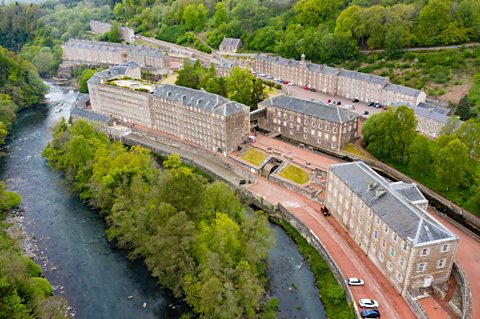 Image source, ALAMY
Image source, ALAMYAs the century progressed, Britain's population began to grow rapidly.
More efficient farming methods were developed and more food could be harvested quicker. More food meant that a larger population could be supported and fed.
At the time of the Industrial Revolution, people got married young age and had lots of children.
As medical care improved, infant mortality decline and more of these children lived to grow into adults.
In the cities, housing conditions and sanitation progressed leading to the reduction of deadly diseases, such as cholera.
As a result of all of these factors, there was a dramatic change in the population size during the 19th century with many people now living in cities such as Glasgow, Dundee, and Edinburgh.
 Image source, ALAMY
Image source, ALAMYPopulation growth, 1801 to 1901
In England & Wales, the population grew by nearly 24 million from 1801 to 1901 – a 365% increase.
In Scotland this was an increase of 278%. It was cities that received the greatest share of this population increase.
| Census year | England and Wales | Scotland | Ireland |
|---|---|---|---|
| 1801 | 8,893,000 | 1,608,000 | Not available |
| 1821 | 12,000,000 | 2,092,000 | 6,802,000 |
| 1841 | 15,914,000 | 2,620,000 | 8,178,000 |
| 1861 | 20,066,000 | 3,062,000 | 5,799,000 |
| 1881 | 25,974,000 | 3,736,000 | 5,175,000 |
| 1901 | 32,528,000 | 4,472,000 | 4,459,000 |
(Source: Changing Britain 1760-1914, J.A. Kerr, 2021.)
Test your knowledge
More on Industrial Revolution
Find out more by working through a topic